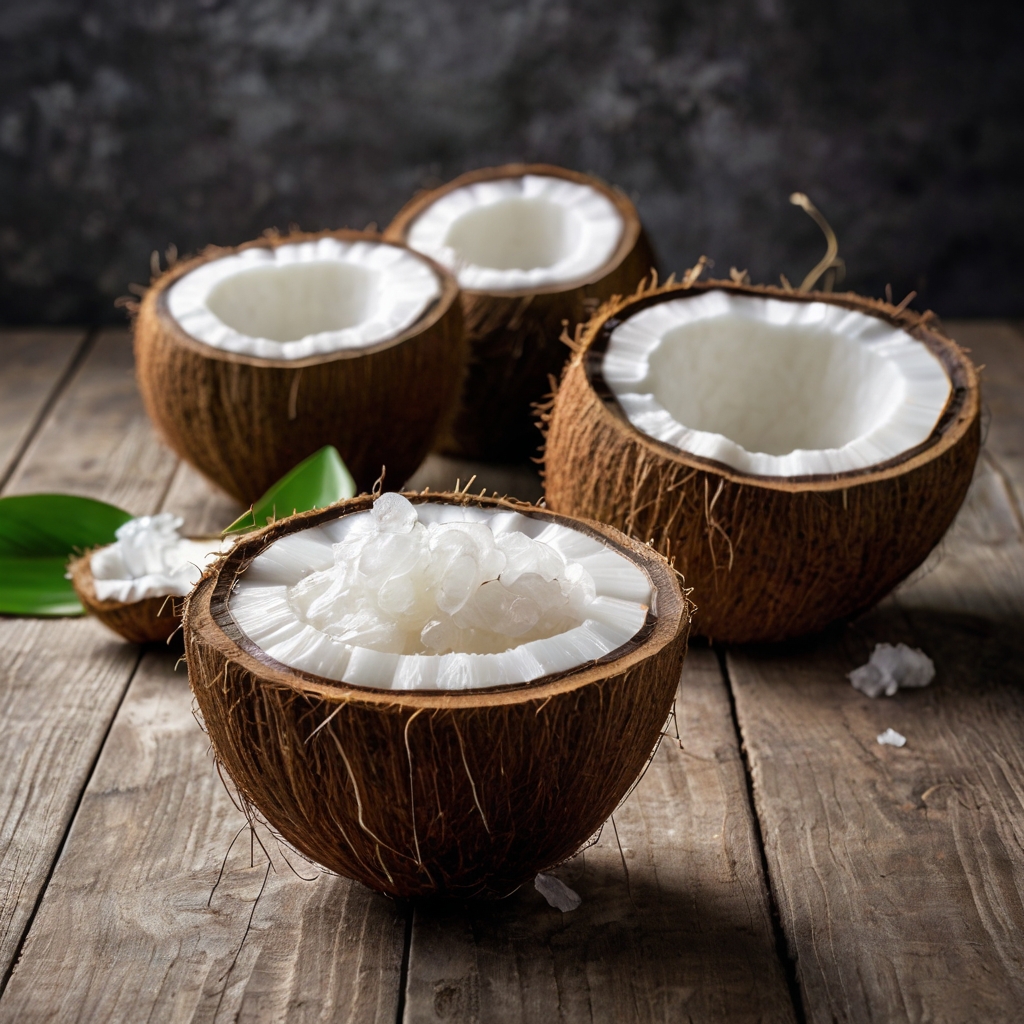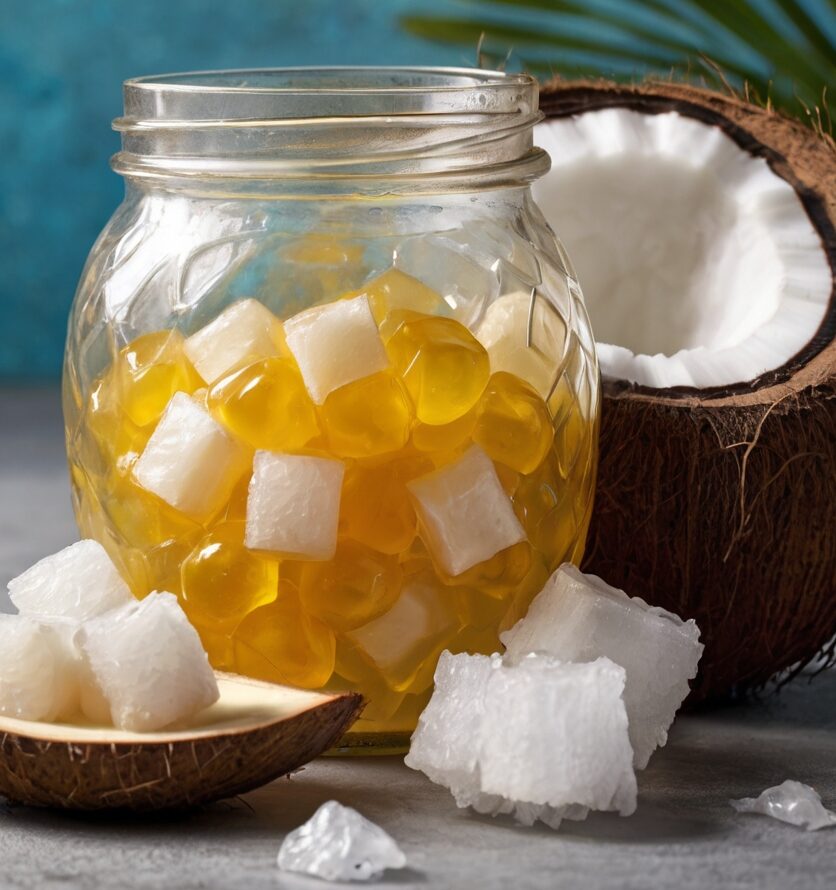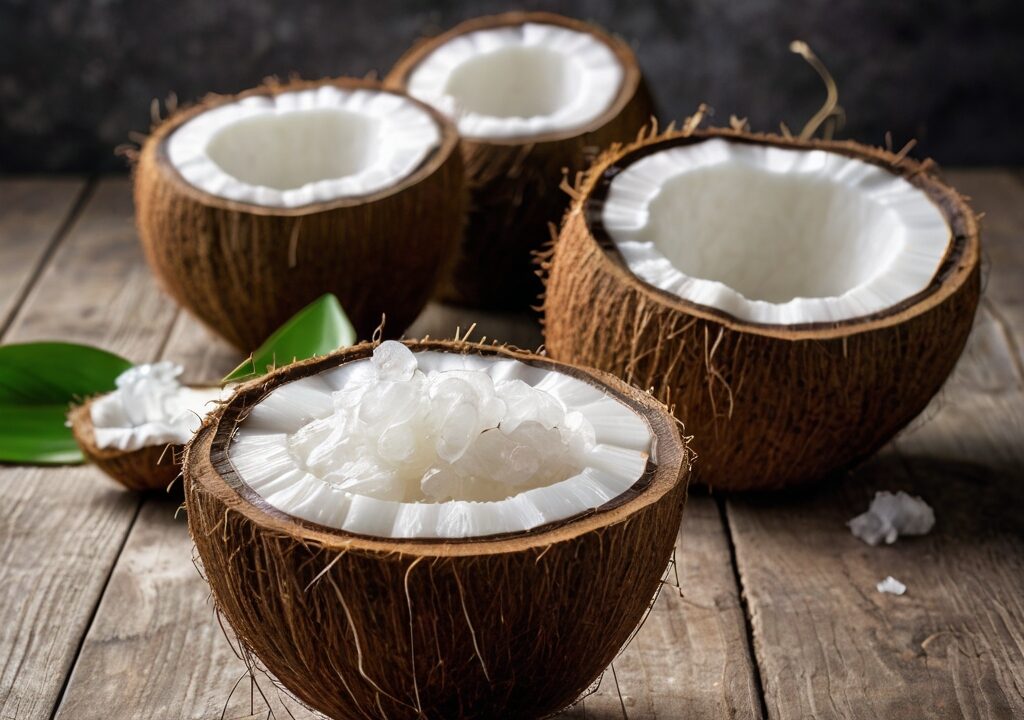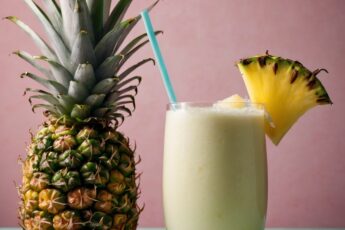How to Make Coconut Jelly
Coconut jelly is a refreshing dessert that breaks apart the moment a spoon touches its silky surface – like fragile silken tofu. You’ll find it at specialty shops like Melo Melo for $7.99 per jar, which can get expensive quickly. The good news is that this beloved Cantonese dessert needs just 5-6 basic ingredients to make at home. This makes it cost-effective and lets you adjust the taste to your liking.
The smooth, firm dessert with its slight jiggle has gained huge popularity over the last several years, especially with places like Melo Melo leading the way. The dessert’s texture sets it apart from pudding or regular jello, giving you a unique mouthfeel that’s close to soft tofu. The recipe is flexible and works great with different sweeteners – you can even use liquid allulose if you want a keto-friendly version. From coconut jelly cubes to lychee variations and summer refreshments, this recipe never fails to deliver. The best part? You can keep this coconut dessert in your fridge for up to 5 days, so it’s perfect to make ahead for events or to enjoy throughout the week.

What is Coconut Jelly and Why Everyone Loves It
Coconut jelly is a beloved dessert that wins over food lovers worldwide. This delightful treat combines coconut milk or coconut water with gelling agents like gelatin or agar-agar to create a perfect balance of refreshing flavors and irresistible texture.
A quick look at its texture and flavor
The magic of coconut jelly lies in its unique texture. It’s not quite a pudding or traditional jello – it feels more like soft tofu in your mouth, smooth and firm but with a gentle jiggle. The jelly looks translucent and gives you a satisfying chewy bite.
The jelly’s delicate coconut flavor stays light and subtly sweet. This gentle taste makes it so popular – you can enjoy it alone or mix it with other ingredients. The dessert uses minimal sugar so the natural coconut flavor really shines through.
Coconut jelly also adds amazing texture to many other treats. People love it:
- In fruit salads and cocktails
- Added to bubble tea and fruit teas
- As a topping for cakes and puddings
How it became popular through Melo Melo
While Asian cuisines have featured coconut desserts for generations, the coconut jelly that’s all over social media comes from Bella Wang, who founded Melo Melo. This California dessert spot specializes in coconut jellies with flavors from mango to matcha.
Melo Melo’s version stands out because of its silky smooth texture and top-quality ingredients. They use fresh coconuts straight from Thailand, making their jelly with pure coconut water and milk. Their signature coconut base tastes amazing even without extra flavors thanks to its incredible silkiness.
Melo Melo opened in San Gabriel, California in 2018 and now has spots all over southern California. They’ve inspired places like Tong Sui up north and Yezi in Seattle. People love them for their quality and creative flavors. Beyond staples like chocolate and coconut oatmeal, they serve seasonal treats such as golden kiwi, purple yam, and papaya.
Cultural roots in Asian desserts
Coconut jelly is just one branch of Asia’s rich coconut dessert tradition. Chinese coconut pudding (椰汁糕), also called Hong Kong coconut pudding, blends coconut milk, sugar and gelatin into a dim sum favorite. This simple dessert hits the spot, especially on hot days.
Vietnamese coconut jelly is one of Hanoi’s oldest jelly dishes, with a sweet taste and lovely coconut aroma. The Vietnamese version often comes in two layers – creamy coconut milk on top and fresh coconut water below.
Hainan Island in China claims coconut jelly as its signature dessert. They make it with fresh coconut milk and tropical fruit pieces for a smooth island treat. The Philippines adds to these variations with Nata de Coco – a chewy, clear food made from fermented coconut water.
Across Southeast Asia, coconut jelly means more than just refreshment. It’s tied to childhood memories, cultural traditions, and shows off the region’s creative cooking spirit.

Essential Ingredients for Perfect Coconut Jelly
The quality of ingredients makes a big difference when you want to create perfect coconut jelly. Premium components work together to give you that silky consistency and delicate flavor profile you’re looking for.
Coconut water vs coconut milk: what’s the difference?
These two coconut products play different roles in your jelly recipe. Young, green coconuts contain clear coconut water. This liquid has fewer calories (about 45-60 calories per cup), no fat, and natural electrolytes like potassium, magnesium, and sodium.
The white flesh of mature coconuts gives us coconut milk. People make it by grating coconut meat, soaking it in water, and straining the mixture. This creamy liquid has way more calories (450-550 per cup) and fat. You’ll find two types of coconut milk for your jelly recipes: canned (thick and creamy) and carton (thinner with stabilizers).
Most recipes use both ingredients. Coconut water creates a refreshing base and coconut milk adds richness with that classic coconut flavor. When you make layered jellies, coconut water gives you a see-through layer, while coconut milk creates an opaque, creamy one.
Choosing the right gelatin or agar agar
Your choice of gelling agent shapes your jelly’s texture. Classic recipes often call for gelatin powder, like Knox brand. You need to “bloom” it (soften in liquid) before heating to get that smooth finish.
Agar agar comes from seaweed and works great as a vegan option with its own special qualities. Unlike gelatin’s wobble, agar sets firmly with a distinctive “snap”. It won’t melt when it’s warm outside – perfect for summer treats. You can swap 1 teaspoon of agar powder for 1 tablespoon of agar flakes.
Sweeteners: honey, sugar, or keto-friendly options
Regular granulated sugar goes into traditional coconut jelly recipes, and you can adjust it based on your priorities and how sweet your coconut ingredients are. You have several other options too:
- Honey: Pick light-colored varieties to keep the jelly white
- Stevia: Research shows mixing 50% sugar with stevia in coconut jelly gets the best taste ratings
- Keto-friendly options: Erythritol, allulose, or monk fruit sweeteners work well for low-carb versions
- Coconut sugar: A natural choice that turns your jelly slightly brown
Optional add-ins: vanilla, pandan, or fruit
Your simple coconut jelly tastes even better with these popular additions:
Vanilla extract adds depth and works well with coconut’s natural taste. Southeast Asian recipes often use pandan leaves for their earthy vanilla-like flavor. Just steep clean leaves in warm (not boiling) coconut mixture for about 30 minutes.
Fresh fruits raise both the look and taste of your jelly. Mango, kiwi, lychee, papaya, and pineapple are crowd favorites. You might want to add tender coconut flesh pieces or create a boba effect with small jelly cubes on top.
Nata de coco (coconut gel cubes), kaong (sugar palm fruit), or creative layering techniques can make your jelly look stunning. These extras help you customize your coconut jelly for different diets or special events.
Step-by-Step Coconut Jelly Recipe (Foolproof Method)
Making silky coconut jelly at home isn’t complicated if you follow these steps. This simple method breaks down the process into easy steps that will give you perfect results every time.
1. Bloom the gelatin properly
The foundation of great coconut jelly starts with blooming your gelatin correctly. Pour ¼ cup of cold water or coconut milk into a small bowl and sprinkle the gelatin powder evenly on top. Give it a gentle stir and let it rest for 5-10 minutes. The gelatin will soak up the liquid and turn into a soft, spongy mass. This vital step keeps your coconut jelly free from lumps.
2. Heat the coconut mixture gently
Mix your coconut water, coconut milk, and your choice of sweetener in a medium saucepan. Keep the heat medium-low and stir now and then until the sweetener dissolves completely. You don’t want the mixture to reach a full boil because that can weaken the gelatin’s power to set. Look for tiny bubbles around the edge of the pan – that’s your signal it’s ready.
3. Combine and strain for smooth texture
Take the coconut mixture off the heat once it’s warm enough. Add your bloomed gelatin to the warm liquid and stir until it melts completely. You’ll get the smoothest results by pouring everything through a fine-mesh sieve into a bowl or pitcher. This catches any stubborn bits of gelatin or coconut solids and gives you that perfect silky finish.
4. Pour into jars and chill
Pour the strained mixture into your serving containers – small mason jars or dessert glasses are perfect. Let them cool uncovered in the fridge for about an hour, then cover them with lids or plastic wrap. This stops condensation from forming on top. The jelly needs 4-6 hours to set properly, but leaving it overnight works best.
5. Add toppings like fresh fruit or coconut jelly cubes
Your coconut jelly comes alive with the right toppings. Fresh fruits like mango, strawberry, pineapple, or dragon fruit add beautiful colors and different textures. You can get creative and make coconut jelly cubes from a separate batch – just cut the set jelly into small squares. On top of that, toasted coconut flakes, a honey drizzle, or some coconut jelly boba can turn this simple dessert into something special.
Temperature control is the biggest factor in getting your coconut jelly right. The gelatin won’t work if it gets hotter than 212°F, so keep that heat gentle. Once you’ve mastered this simple recipe, you can try all sorts of variations – from lychee coconut jelly to chocolate-infused versions.
Customizing Your Coconut Jelly for Any Diet
Coconut jelly’s adaptability goes well beyond its simple recipe. This tropical treat makes an ideal dessert that fits almost any dietary need without losing its taste or texture.
Vegan version using agar agar
Agar agar comes from seaweed and works perfectly as a vegan alternative to animal-derived gelatin. People who follow plant-based diets can use 1½ tablespoons of agar agar flakes to get similar results. Note that agar needs different handling – you must boil it to activate its gelling properties at temperatures above 80-90°C. The texture becomes firmer and slightly springier than gelatin, but it gives a clean, smooth finish that vegans love. Agar also sets at room temperature in about an hour, which is much faster than gelatin.
Keto-friendly with allulose or monk fruit
Coconut jelly works great for people watching their carb intake. You can swap traditional sweeteners with granulated monk fruit sweetener containing allulose or plain allulose. This helps avoid the crystallization problems that often happen with erythritol-based sweeteners after chilling. Liquid allulose is another good choice—about ⅓ cup works perfectly instead of honey in regular recipes. These alternatives create a tasty low-carb dessert while keeping the smooth texture and delicate flavor profile intact.
Dairy-free and paleo options
Coconut jelly is naturally dairy-free and becomes a great paleo-friendly dessert with a few tweaks. Mix coconut milk and coconut water with raw honey for natural sweetness. Paleo recipes work best with grass-fed gelatin (about 2 tablespoons or 20 grams) bloomed in cold water before adding it to heated coconut cream. This version takes just 15 minutes to prep plus chilling time. The result is a refreshing treat that fits paleo guidelines perfectly.
Flavor twists: lychee coconut jelly, mango, or pandan
The possibilities for flavor variations seem endless. Lychee coconut jelly blends full-fat coconut milk with lychee juice to create a fragrant tropical dessert. Mango juice or any pulp-free tropical juice works just as well. Adding pandan leaves brings an earthy vanilla-like flavor that’s common in Southeast Asian desserts. You can try combinations like mango-pandan or add diced fresh fruits as mix-ins. These variations stay fresh in the fridge for 2-3 days, but they taste best when served cold.
Serving, Storing, and Troubleshooting Tips
Good coconut jelly storage and presentation can make your dessert stand out or fall flat. Even the best-prepared jellies need special care to stay fresh.
How to prevent separation
Coconut fats naturally rise to the top while cooling and cause separation in coconut jelly. You can prevent this layered effect by gently stirring the mixture every few minutes as it cools. Recipes that use both coconut milk and coconut water need vigorous whisking throughout preparation to maintain consistency. Quick cooling in a refrigerator at a lower temperature helps the jelly solidify before separation occurs.
Best containers to use
Your choice of containers impacts both looks and storage efficiency. Small glass jars, ramekins, or dessert cups work great for individual servings. Clear cups with lids make excellent choices if you plan to give them as gifts. Many people love to reuse Oui yogurt jars or Melo Melo containers to create an authentic look. Silicone or plastic containers make it easier to unmold the jelly if you want to serve it outside its container.
How long it lasts in the fridge
Your coconut jelly stays fresh for 3-5 days in a covered container in the fridge. Store-bought coconut jellies usually last 2 weeks after opening in the refrigerator. Unopened shelf-stable products can last up to 18 months in cool, dry places away from direct sunlight.
Fixing texture issues (too firm or too soft)
A too-firm jelly can be fixed by gentle reheating without boiling and adding more liquid. If it’s too soft, warm the mixture slightly and add bloomed gelatin to give it more structure. Note that heating above boiling point can cause separation.
Using it in coconut jelly boba or desserts
Coconut jelly works great as an ingredient in other treats. Small cubes of jelly make perfect toppings for shaved ice, frozen yogurt, or ice cream. Of course, it adds an interesting texture to bubble tea and smoothies. The jellies also work well as chewy bits in fruit cocktails and tropical dessert bowls.
Summing all up
Coconut jelly is one of the most versatile desserts you can make at home. This silky treat turns from an expensive café indulgence into a budget-friendly delight with just a few ingredients and the right technique. The best part about coconut jelly is how adaptable it is. You can make a vegan version with agar agar, try a keto-friendly version with allulose, or stick to the traditional recipe with gelatin.
Your coconut jelly’s texture will be perfect every time if you bloom the gelatin correctly. Heat your coconut mixture gently and strain it well for smoothness. The options for toppings, mix-ins, and flavor combinations are endless, which makes this refreshing dessert exciting. Each version brings something special to the table – from lychee coconut jelly to mango infusions and traditional pandan varieties. These variations showcase this treat’s delicate flavor profile.
Coconut jelly started in Asian cuisine and now people worldwide love its refreshing taste and smooth texture. The next time you want something sweet and light, a perfect batch of coconut jelly is just a few steps away. You can make it better than specialty shops and save money too. The satisfaction of creating it yourself makes it even more special.
Here are some FAQs about how to make coconut jelly:
What is coconut jelly made out of?
Coconut jelly is primarily made from coconut water or coconut milk combined with a gelling agent like agar-agar or gelatin. The coconut jelly cubes version typically includes these ingredients set in cube-shaped molds. Many coconut jelly recipe variations also incorporate sugar and sometimes fruit flavors for additional taste.
Is coconut jelly good for you?
Plain coconut jelly can be a healthy snack as it’s low in calories and contains some nutrients from the coconut. However, coconut jelly cubes with added sugar should be consumed in moderation. When preparing coconut jelly recipe at home, you can control the ingredients to make a healthier jelly coconut dessert.
Is coconut gel the same as coconut jelly?
Coconut gel and coconut jelly are similar but may have slight texture differences based on preparation methods. While both use coconut as the base, coconut jelly cubes tend to have a firmer consistency than some coconut gel products. The coconut jelly recipe you follow will determine whether the result is more gel-like or jelly-like.
What does coconut jelly taste like?
Natural coconut jelly has a mild, slightly sweet coconut flavor with a refreshing quality. The taste of coconut jelly cubes can vary depending on whether they’re made from coconut water or coconut milk. Many jelly coconut products have a delicate tropical flavor that pairs well with fruits and other desserts.
Does coconut jelly contain sugar?
Traditional coconut jelly recipe often includes sugar as an ingredient for sweetness. However, sugar-free coconut jelly cubes can be made using alternative sweeteners or no sweetener at all. When buying commercial jelly coconut products, it’s important to check the label for sugar content.
What is jelly actually made of?
Basic jelly is made from fruit juice or other flavored liquids combined with a gelling agent. This differs slightly from coconut jelly recipe which specifically uses coconut-derived liquids. While standard jelly uses pectin, many jelly coconut preparations use agar-agar or gelatin as the setting agent.




